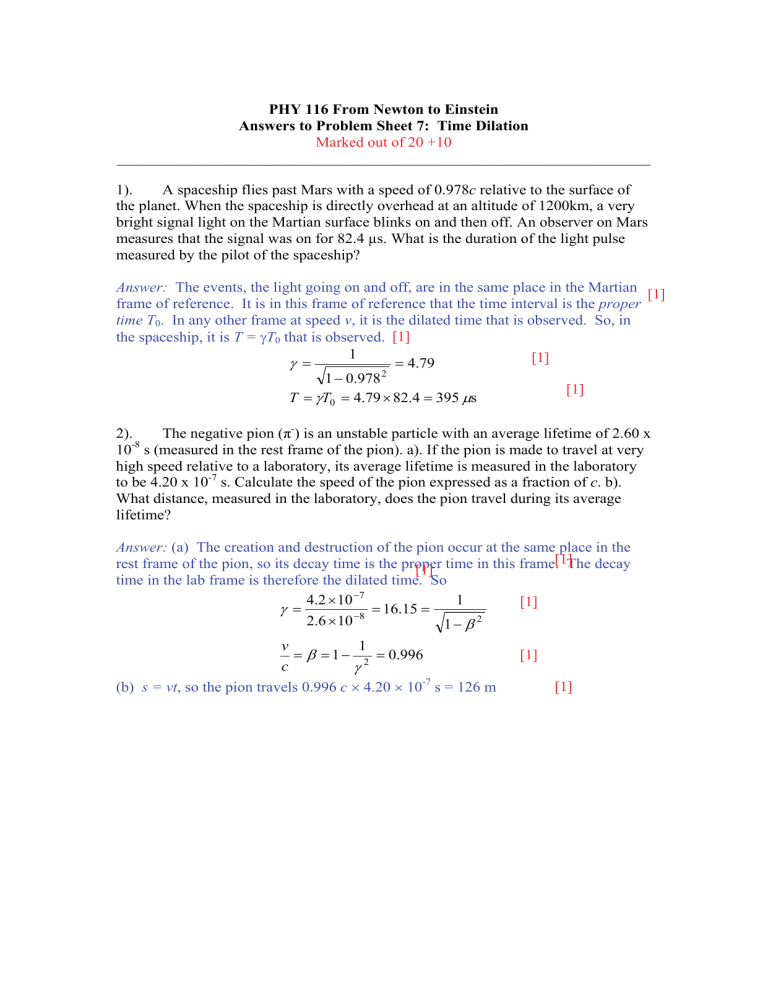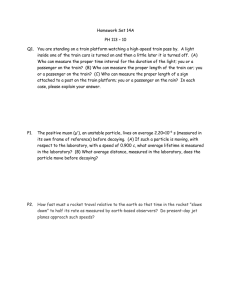
PHY 116 From Newton to Einstein Answers to Problem Sheet 7: Time Dilation Marked out of 20 +10 _____________________________________________________________________ 1). A spaceship flies past Mars with a speed of 0.978c relative to the surface of the planet. When the spaceship is directly overhead at an altitude of 1200km, a very bright signal light on the Martian surface blinks on and then off. An observer on Mars measures that the signal was on for 82.4 µs. What is the duration of the light pulse measured by the pilot of the spaceship? Answer: The events, the light going on and off, are in the same place in the Martian [1] frame of reference. It is in this frame of reference that the time interval is the proper time T0. In any other frame at speed v, it is the dilated time that is observed. So, in the spaceship, it is T = T0 that is observed. [1] 1 [1] 4.79 2 1 0.978 [1] T T0 4.79 82.4 395 s 2). The negative pion (π-) is an unstable particle with an average lifetime of 2.60 x -8 10 s (measured in the rest frame of the pion). a). If the pion is made to travel at very high speed relative to a laboratory, its average lifetime is measured in the laboratory to be 4.20 x 10-7 s. Calculate the speed of the pion expressed as a fraction of c. b). What distance, measured in the laboratory, does the pion travel during its average lifetime? Answer: (a) The creation and destruction of the pion occur at the same place in the [1] rest frame of the pion, so its decay time is the proper [1] time in this frame. The decay time in the lab frame is therefore the dilated time. So 4.2 10 7 1 [1] 16.15 8 2 2.6 10 1 v 1 1 2 0.996 c (b) s = vt, so the pion travels 0.996 c 4.20 10-7 s = 126 m [1] [1] 3). As you pilot your space utility vehicle at a constant speed towards the moon, a racing pilot flies past you in her spaceracer with a constant speed of 0.8c relative to you. At the instant the spaceracer passes you, both of you start timers at zero. a) At the instant when you measure that the spaceracer has travelled 1.20 x 108 m past you, what does the racing pilot read on her timer? b) When the racing pilot reads the value calculated in part (a) on her timer, what does she measure to be her distance from you? c). At the instant when the racing pilot reads the value calculated in part (a) on her timer, what do you read on yours? Answers: (a) The two events on your timer take place at the same place, so the s 1.2 10 8 0.5 sec . [1] interval is a proper time in your frame, of TE v 0.8 3 10 8 Consequently, it is a dilated time in the spaceracer’s frame, to be compared with her proper time TS . So TS T TE TS S 1 0.8 2 0.6 [1] TS 0.6TE 0.3 s (b) She measures you to be receding at 0.8 c, so when she reads 0.3 sec she knows [1] that you are at 0. 3 × 0.8 light-seconds away = 0.24 × 3 × 108 = 7.2 × 107 m (c) Her interval of 0.3 s is between two events that happened in the same place in the spaceship. But you reading your timer occurs in your frame,[1]so you are reading a proper time corresponding to her dilated time. Consequently, you read 0.6 times her [1] reading, or 0.16 s. A spacecraft flies away from the Earth with a speed of 4.80 x 106 m/s relative 4). to the Earth and the returns at the same speed. The spacecraft carries an atomic clock that had been carefully synchronised with an identical clock which remains at rest on the Earth. The spacecraft returns to its starting point 365 days later, as measured by clocks that remained on the Earth. What is the difference in elapsed times on the two clocks, measured in hours? Which clock, the one on the spacecraft or the one on Earth, shows the smallest elapsed time? v 1 0.016 , so 1.00013 . The atomic clock measures the 2 c 1 [1] [1] proper time TS on the spaceship, so time on Earth is dilated, i.e. 365 days = TS. So TE TS 1.12hours [1] The spaceship clock therefore records the smaller elapsed time. Answer: 5). An alien spacecraft is flying overhead at a great distance from you. You see its searchlight blink on for 0.19 s. On the spacecraft they measure the searchlight as being on for 12 ms. a). Which of these two times is the proper time? b). What is the speed of the spacecraft relative to the Earth expressed as a fraction of the speed of light? Answer: (a) The searchlight switched on (Event 1) and switched off (Event 2) in the same place in the spacecraft frame of reference. The time measured on the spacecraft [1] is therefore the proper time. You are travelling at some velocity with respect to this frame, your measured time is therefore the dilated time. Answer: (b) The dilated time is T=190 ms, the proper time T0 is 12 ms. So T T0 T 190 15.8 12 T0 1 v 1 2 0.996 c [1] [1]



